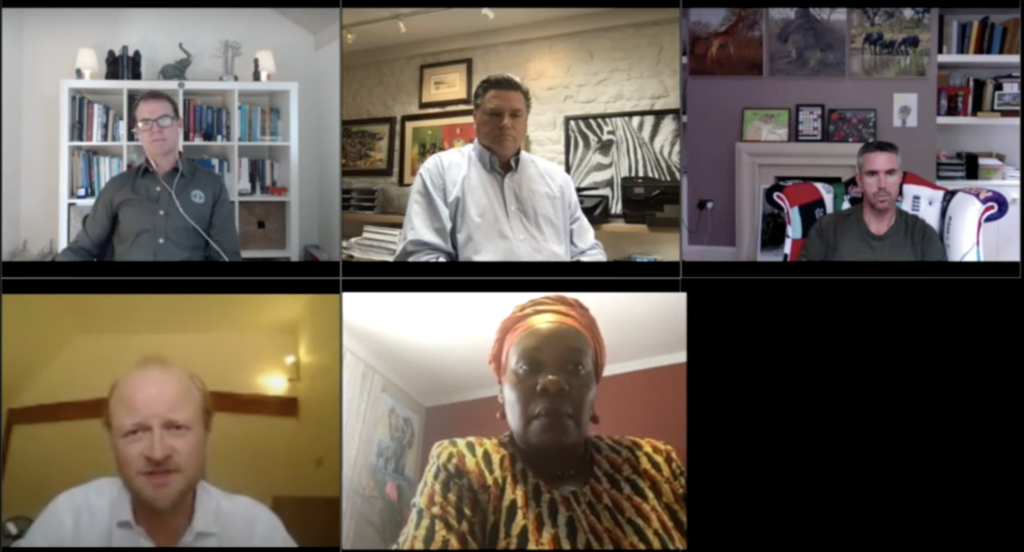The protection of Africa’s wildlife and wild places has for a long time depended on a model underpinned by tourism. In a Covid-19 world, what are the implications for conservation, how will wildlife economies change, and where are the opportunities?
Last Thursday, Paul Milton joined three other conservation experts to discuss these questions in depth: John E. Scanlon, African Parks Special Envoy; Kevin Pietersen MBE, cricket player turned conservation influencer and founder of SORAI; and Dr. Winnie Kiiru, Trustee of Kenya Wildlife Service and Advisor to various conservation organisations.

Alexander Rhodes, Head of Mischon Purpose at Mishcon de Reya, and host of Thursday’s webinar, introduced the subject matter, taking the lead from TUSK on how Covid-19 has impacted conservation in a number of jurisdictions – it is the economic consequences of the global lockdown, as opposed to the health crisis itself which is the main issue.
Before the coronavirus pandemic, WTO stated that 80% of travel to Africa was for the wildlife, supporting almost 24 million jobs, a number that was expected to double by 2030, and the 8400 protected areas across Africa saw over $30 billion of in-country expenditure. Yet, the evident value of Africa’s natural assets is threatened by a lack of sustainable management and funding.
Thursday’s response to these issues were clear, and agreed upon emphatically by all parties, representative of government, public and private sectors: global players at all levels need to collaborate to develop and implement a conservation model aligned with the common purpose of building economic resilience and sustainability across Africa, and globally. Alongside this, the definition of ‘value’ in conservation and wildlife tourism must be broadened to beyond just financial profit – diversity, inclusivity, and a particular focus on local communities as stakeholders, not just beneficiaries, should be demonstrative and inherent in the meaning of ‘value’.
John E. Scalon and Dr Winnie Kiiru both remarked on how ‘this pandemic has shown the interconnectivity of the global’, with a similar observation made for conservation as an issue not only for, or only present in, Africa. Winnie relayed how many wildlife destination are generally low GDP countries who bear a majority of the conservation cost, financial and otherwise. She called for more international support, denoting all populations around the globe as collaborators in the conservation effort. Emphasis was placed on how this global collaboration must avoid a ‘top-down’ narrative; diverse voices need to be included in all phases of Africa’s conservation model, ranging across ages, genders, ethnicities, to extract maximum potential, thereby creating a solid model for others to follow.
Kevin Pietersen correspondingly posed the key question of how we bring these diverse global forces together, from the local, foundation, private and government sectors, to secure effective management and funding for wildlife across Africa. As both John and Paul replied, conservation is a health, security and development matter that requires an investor, not donor, mindset; by viewing the terms ‘investor’ and ‘return’ more holistically, we can widen the metrics of wildlife tourism returns beyond just the financial to include an enhancement of biodiversity, achievement of SDGs, community uplift, and likewise, thereby providing ‘value’ for a global set of assorted stakeholders, who find alignment and purpose in a broader set of outcomes. Milton Group’s conservation model which utilises natural and social capital methodologies fits well within this broadening; demonstrating that natural and social capital can be measured, tracked, mitigate risk and create value has been a key part of aligning government, public and private parties across the firm’s projects.
Paul also observed that the last 90 days have been crisis management focused for wildlife tourism and hospitality ventures across Africa, struggling with the potential market compression gap that could last for a possible 3-5 years. The main victims are the 3*- 4* wildlife hospitality products, who have insufficient funding when compared to the larger, international brands. Many of these properties sit within small portfolios, now appearing on an increasingly flooded distressed market. With this in mind, as Dr Kiiru said, we need to reset our approach towards wildlife economies and question whether an economy supported purely by the current wildlife tourism model is sustainable – the conferred answer was no.
Governments can look towards domestic tourism expansion as an in-part solution; Rwanda recently announced that gorilla permits are now being offered to the local market for $200, down from the pre Covid – 19 levels at $1500, marketing the experience more feasibly to the local market. Yet, for the masses that are dependent on wildlife tourism as a means of livelihood, alternative economies are essential. Conservation models have previously been guilty of narrowed thinking, concentrating only inside the protected area boundaries, but increasingly, buffer zone and surrounding social development has been identified as fundamental to sustainability. Agriculture and aquaculture offer just two examples of alternative livelihoods that can derive from well managed and effective conservation based-tourism models, as exampled by Karingani Game Reserve, a Milton Group project in Mozambique.
The reality is that the long-term future of protected areas is dependent on local communities; through an internationally and diverse collaborative approach to conservation tourism, where holistic returns are valued just as much and perhaps more than the financial, we can start to embed economic resilience and sustainability within some of the world’s most threatened spaces.
Nadine Manji, Milton Group Analyst


 By miltongroup, July 8, 2020
By miltongroup, July 8, 2020